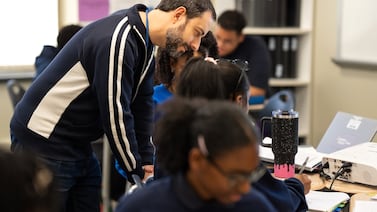Sign up for Chalkbeat Indiana’s free daily newsletter to keep up with Indianapolis Public Schools, Marion County’s township districts, and statewide education news.
On Mondays, Stephanie Quinlan writes out menus for the Perry Township Academic Center’s food pantry in English, Spanish, Burmese, Arabic, and four other languages spoken by Perry Township school district families.
Then on Tuesday mornings, the parking lot fills up with trucks dropping off fresh produce and other supplies.
When this pantry first opened at Southport High School in 2019, it served just seven to 10 families weekly. But when the parking lot fills up again on Tuesday afternoons, about 150 people show up to use it.
“Each week I may have … someone who comes in for the first time that says, ‘I just lost my job today and saw your sign on the street,’” said Quinlan, the district’s assistant director of student services, who runs the pantry. “And it’s like, yeah? Come on in. Here we go.”
The district’s food pantry will open again this Tuesday. But something is different this time: There’s major uncertainty over when millions of people will receive their federal Supplemental Nutrition Assistance Program benefits during the ongoing government shutdown.
Though federal judges have ruled that the Trump administration must use emergency money to partially fund the program, it was still not clear Monday when recipients would see the funds. Treasury Secretary Scott Bessent said the funds could be released by midweek. The Trump administration also said Monday that it would partially fund SNAP benefits.
As a result, school and city food pantries have been preparing to serve an uptick in the number of students and their families who need food assistance until the benefits are released. Around 600,000 people in Indiana — including 260,000 children — use SNAP.
A list of food pantries in Indianapolis is available here from the Indianapolis Star, and here from Mirror Indy.
When families’ food budgets are squeezed, there are ripple effects for other student needs, said Hanna Yaeger, director of community engagement at Teachers’ Treasures, a nonprofit organization that provides free supplies to teachers at qualifying schools.
“Ultimately a parent has to make a decision — and you should choose food over pencils,” Yaeger said. “We’re there to make sure when you make that choice you have everything you need.”
Quinlan said most of the people who visit the Perry Township pantry also receive SNAP. Typically, the pantry is at its busiest at the end of month when families are stretching their meal budgets, she said.
The program has grown steadily since it moved to the academic center in 2022 as more and more people learn about it, Quinlan said. It is now nearing capacity: Last week, it had to turn away cars for only the second time ever.
The pantry is funded in part by the Emergency Food Assistance Program from the U.S. Department of Agriculture, as well as Gleaners, the largest food bank in Indiana. Quinlan said the USDA funding has been granted through June and so far has not been affected by the shutdown.
The USDA program typically provides products like black beans or frozen chicken breasts in bulk. That establishes a starting point for Quinlan to shop for the rest of the pantry with a $1,400 monthly budget from Gleaners.
The emergency food program requires Quinlan’s volunteers to ask patrons if they meet the household income requirements — but they will receive food even if they don’t. The pantry doesn’t have ZIP code requirements, but if multiple households are arriving in one car, volunteers will ask for proof of each one’s address.
Patrons of the pantry park in one of the spots outside the center and wait to speak to a greeter or Quinlan herself, who will hand them a menu of available produce, dairy, meat, and packaged goods. They then choose what they want, and volunteers “shop” for them and load it into their cars.
This is a draw for senior citizens and people with mobility needs who visit the pantry, Quinlan said.
Diapers are one of the most requested items, Quinlan said, but purchasing diapers would take up half the budget for the pantry, so the staff waits until they have enough donated to give away.
Quinlan said the pantry takes individual donations of food — ideally in large enough quantities to be able to offer to all the patrons of the pantry that week. Cash donations also allow her to purchase much more food through Gleaners than the average person could get at a grocery store.
“Ideally, we empower families to make their decisions and be able to get out of where they are now, not to rely on us forever,” she said.
Teachers’ Treasures works with traditional public, charter, and private schools in Indianapolis. One of those private schools — Central Catholic School — operates a food pantry that around 170 of the school’s 230 students visit, said Ariana Jehl, a teacher and Teachers’ Treasures advisory board member. The school is anticipating increased need, she said.
While Teachers Treasures doesn’t specialize in food, the organization accepts some non-perishable shelf items — ramen, easy mac, and water bottles — that teachers pick up, along with hygiene items to donate to their school pantries.
For Quinlan, her first shopping trip to Teachers’ Treasures yielded five silver thermal covers to be used to keep food cold.
Teachers’ Treasures has also seen a growing need for food and snacks, Yaeger said.
“We realize it’s reality,” she said.
Aleksandra Appleton covers Indiana education policy and writes about K-12 schools across the state. Contact her at aappleton@chalkbeat.org.






